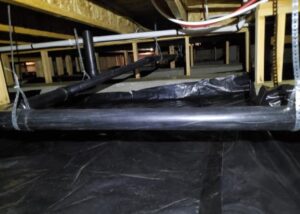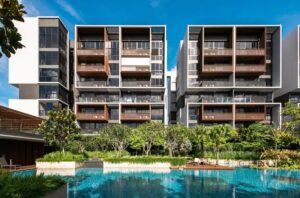Real Estate newsletter: Luxury finds a new extreme

Welcome back to the Real Estate newsletter. It’s been a relatively quiet summer on the luxury front, but this week, we finally saw the extremes that the Southern California market is capable of.
First, we stopped by a dinner party in West Hollywood. The dinner: Champagne, caviar and filet mignon with caramelized heirloom truffle. The party: a mix of L.A.’s top real estate agents catered to by “personal concierges” and entertained by a live singer in a glittery red gown.
The occasion: the opening of a stunning new penthouse that’s on the market for a whopping $50 million. If it gets its price — or anything close — it will be the priciest condo sale in L.A. history, and we explored how such a price tag even became possible.
We also checked in on the market up the coast, where a famous student housing complex in Berkeley traded hands for $112.9 million.
If you’ve ever been in the area, you’ll surely recognize the place. Known as the Enclave Apartments building, the seven-story complex looks like it belongs in a theme park more than a college town, with a whimsical exterior marked by craggy cliffsides and palace-like ornamentation.
As one critic mused: “It’s as if Harry Potter and Fred Flintstone decided to build a McMansion.” Eyesore or not, it’s a welcome reprieve from the current explosion of box-like homes and apartment buildings dotting L.A.
Speaking of unique style, the week’s biggest residential sale closed in Bel-Air, where Tinder co-founder Sean Rad shelled out $35 million for a one-of-a-kind compound owned for decades by actress Yvette Mimieux.
Whereas many modern homes aim for sleek, minimalist style, this one runs in the opposite direction, embracing extravagant, over-the-top spaces with bizarre bohemian design. The photos alone are worth a click — or a subscription.
A film producer is chasing an even bigger price in Carpinteria. Sarah Siegel-Magness, whose biggest credit is the 2009 hit “Precious,” is asking $50 million for her 61-acre polo estate that has hosted players as famous as Prince Harry.
Polo is definitely the biggest draw. Unless you’re fine sleeping under the stars on one of the compound’s two polo fields, the only place to sleep is an Airstream trailer — though it does look quite nice in that glamping sort of way. The property has plenty of living potential, however; it’s zoned for residential use with two parcels that could hold houses, guesthouses, swimming pools and tennis courts.
We were also treated to a transmission from Tyrone Beason, who headed to the Inland Empire for the latest installment in his series called “My Country,” which sees him travel around in search of signs of healing during our divided times.
Beason entered with skepticism and left with a deeper understanding of why 4.6 million Californians — most of them people of color — chose a land that’s been dubbed “a harsher California.”
As always, while catching up on the latest, visit and like our Facebook page, where you can find real estate stories and updates throughout the week.
Luxury condo looks to redefine the market

Guests sit for dinner during a VIP event in West Hollywood at 8899 Beverly.
(Brian van der Brug / Los Angeles Times)
To unveil one of the grandest penthouses ever to be built in Los Angeles, its developers threw a little dinner party, writes Andrea Chang.
Two dozen of L.A.’s top real estate agents — the sunglasses-indoors kind who regularly appear on reality television — were tended to by a cadre of young women in identical cream-colored outfits, hired for the evening to serve as “personal concierges.” Eight hundred gardenias were flown in from a Bay Area flower farm, separated into individual vases and spaced exactly 4 inches apart on a long tablecloth-draped table. There was welcome Champagne and caviar blinis, a singer in a glittery siren-red gown, and filet mignon with “caramelized heirloom truffle.”
Up for grabs: the city’s latest showstopping eight-figure penthouse, a decade in the making and finally for sale for $50 million off-market at arguably the most coveted time ever for luxury condos in L.A. If it sells at that price, it’ll break the county’s all-time condo sales record of $35 million, for a Century City penthouse that Candy Spelling bought in 2010 when she was looking to downsize.
A sizable marketing machine is now spinning up to get a blockbuster deal done soon, before looming economic concerns threaten to damp rich-buyer behavior. Developer Townscape Partners has been stoking anticipation for the penthouse for years and is looking to capitalize on L.A.’s scorching luxury condo market, which continues to rack up enormous sales even as real estate overall has started to cool.
A ‘Moorish-Tudor fever dream’ sells for $112.9 million

The Enclave Apartments are a mixed-use student housing complex at Telegraph Avenue and Haste Street in Berkeley.
(John Sutton Photography/LCA Architects)
A student housing apartment complex in Berkeley known for its unusual, castle-like design has sold for more than $100 million to a group led by Goldman Sachs, writes Jonah Valdez.
The Enclave Apartments building on Telegraph Avenue, a few blocks from the UC Berkeley campus, was purchased by an affiliate group headed by the Wall Street firm in an all-cash deal for $112.9 million, according to public records.
The mixed-use seven-story building, with a facade evoking craggy cliffsides, can house 252 students in dormitory-style units. It includes commercial retail space on the first floor, which sits mostly vacant with the exception of a sandwich shop.
“It’s as if Harry Potter and Fred Flintstone decided to build a McMansion. On acid,” remarked a critic with the San Francisco Chronicle, who also described the complex as a “Moorish-Tudor fever dream.”
Tinder founder lands a whimsical compound

Tucked in the middle of the Bel-Air Country Club golf course, Sean Rad’s estate spans 1.5 acres.
(Hilton & Hyland)
Not many homes look like the one owned by Yvette Mimieux. Not in Southern California. Not anywhere.
The colorful two-house Bel-Air compound — a bohemian bouquet of art and architecture — surfaced for sale at $49.5 million after Mimieux, star of the 1960 film “The Time Machine,” died at 80 in January.
Records show it has a notable new owner: Tinder co-founder Sean Rad, who paid $35 million for the fanciful estate.
The compound is tucked on an island of sorts in Bel-Air, where the Bel-Air Country Club golf course wraps around a coveted collection of luxury homes, creating a private haven shielded from the city. It has been dubbed “Il Sogno” — Italian for “the dream.” Both houses shirk modern style in favor of extravagant, over-the-top Old Hollywood style.
Film producer lists her prized polo estate

The 61-acre compound includes two parcels with two polo fields, equestrian facilities, a lounge and an Airstream trailer.
(Rial Productions)
Some listings are all about the house. This one is about everything besides the house.
In Carpinteria, a working polo ranch has surfaced for sale at $50 million. It’s being shopped around by Sarah Siegel-Magness, a film producer whose credits include “Precious” and “Tennessee.”
The estate is known as Cancha de Estrellas — Spanish for “field of stars” — and has hosted celebrities including Prince Harry for a game of polo. The horseback game is definitely the biggest draw; technically, the only place to sleep is a chic Airstream trailer tucked at the edge of the property.
“Polo is a male-dominated sport, generally speaking, so the rarity of this property is that it has a woman’s touch with the landscaping,” Siegel-Magness said. “It has a different aesthetic than other polo properties, which can be very utilitarian.”
A writer’s journey to the Inland Empire

Beaumont and neighboring Banning were once separated by a city street, with white people on one side and Mexican American and Black residents on the other.
(Myung J. Chun / Los Angeles Times)
Tyron Beason writes that his ideas about the Inland Empire have always been seeded with a prickly skepticism.
But he was intrigued by the most recent U.S. census figures showing the Inland Empire to be one of the fastest-growing regions in the country and that waves of Black and brown transplants, many from Los Angeles and Southern California’s other urban centers, had driven a cultural transformation decades in the making.
The population has swelled to 4.6 million people spread across Riverside and San Bernardino counties — and an area that was once known for its whiteness is now about 70{3ad958c56c0e590d654b93674c26d25962f6afed4cc4b42be9279a39dd5a6531} people of color.
The presence of Black and brown faces isn’t new, but when Beason set out to understand why so many are packing up and moving to the Inland Empire now, he learned that it wasn’t simply because the region is regarded as a bastion of affordable housing in pricey Southern California.
“There was something else — a yearning that you can’t easily measure in numbers,” Beason writes.
What we’re reading
Although the housing market has gotten slightly less competitive, it doesn’t seem fair that buyers are finding themselves outbid by one of the richest men in the world: Jeff Bezos. A startup backed by the Amazon founder has bought 59 properties for a total of $23 million in the last month alone, joining the growing group of tech companies that are scooping up single-family homes with a profit in mind. Benzinga has the story.
Real estate agents used to just sell homes to celebrities. Now, many are celebrities themselves. Realtor.com looked at the trend, which started with HGTV and Bravo and exploded during the pandemic to streaming services and more, as luxury mansions (and the ones selling them) became much more fascinating when we were all stuck in our own houses.








